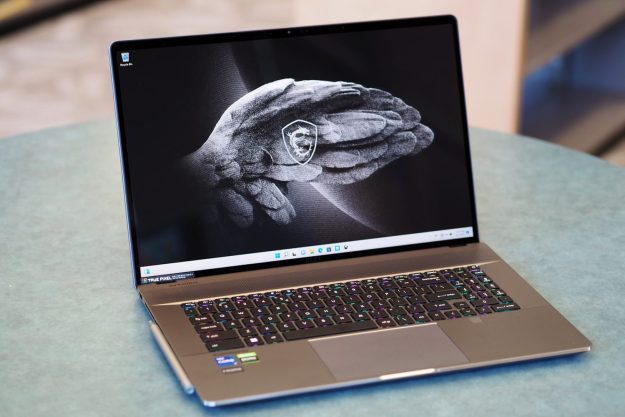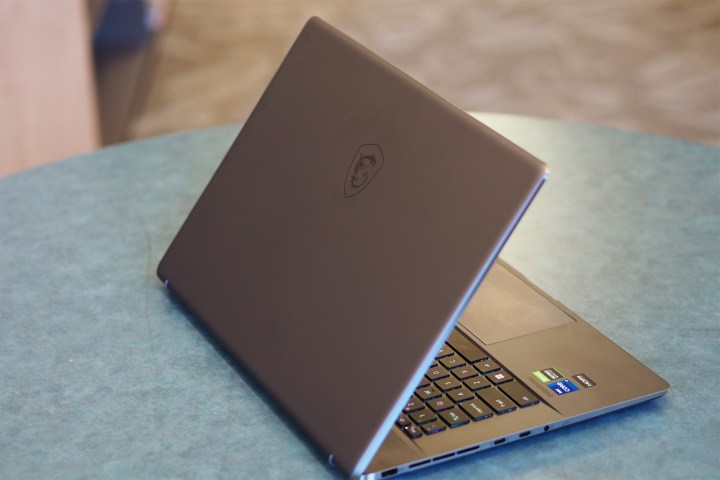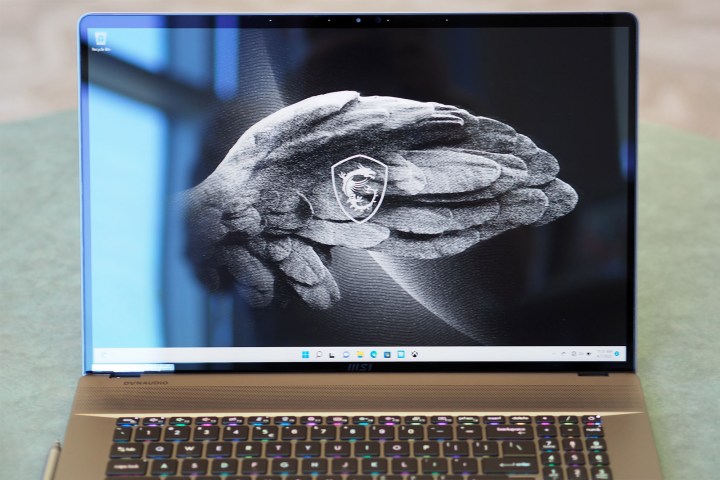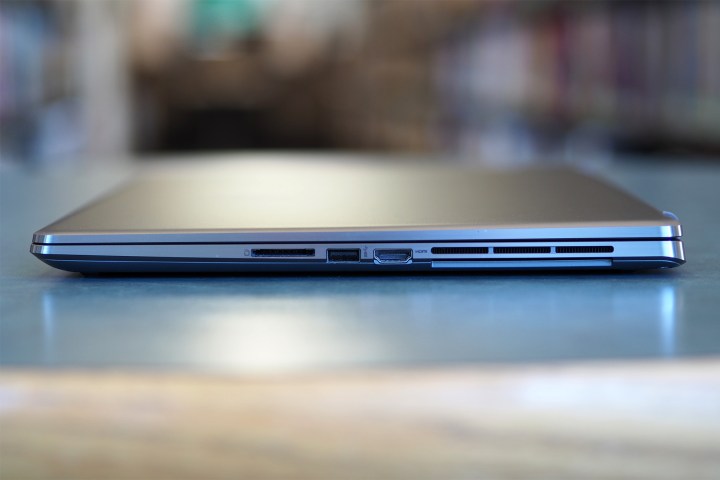
- Excellent productivity and creative performance
- Good gaming performance
- Great keyboard and touchpad
- Active pen support
- Solid build quality
- Attractive aesthetic
- Expensive
- Display is a step behind the best
- Poor battery life
- Heavy
The M1 Max MacBook Pro shook the industry — there’s no question about that. But that doesn’t mean there aren’t some great choices on the Windows side of the aisle, especially devices using the latest 12th-gen Intel chips and Nvidia graphics cards.
The MSI Creator Z17 is one such machine, an attractive laptop with a large 17.3-inch display and some impressive performance potential.
It’s not cheap, though. I reviewed the $3,249 configuration, which is the entry-level Creator Z17. That’s quite a lot of money, even for this level of components. The Creator Z17 is a high-performing machine with a solid design and decent display, but the price remains a sticking point, especially compared to the competition.
Design

The Creator Z17 is built around a 17.3-inch 16:10 IPS display with small bezels that comes in at an impressive 91% screen-to-body ratio. Even so, it’s a large laptop at 15.04 inches wide by 10.24 inches deep by 0.75 inches thick and weighing in at 7.4 pounds. There aren’t many other 17-inch
The Dell is 14.74 inches wide by 9.76 inches deep by 0.77 inches thick, and it weighs significantly less at 4.87 pounds. That makes the Creator Z17 larger in all dimensions except for thickness and surprisingly heavy. Both
Certainly, it’s not a difference in construction. The Creator Z17 is a solid laptop, with just a slight bending in the lid and no flexing in the keyboard deck or bottom chassis. But the XPS 17 is even more sturdy, with no flexibility in the lid. The Dell XPS 15 and Apple MacBook Pro 16 are also more rigidly built, putting the Creator Z17 a small step behind some of its most important competition. MSI did design the Creator Z17 to meet military durability standards, which adds some confidence in the laptop’s survivability.
Aesthetically, the Creator Z17 is a conservatively attractive laptop in its Lunar Gray (dark gray) color scheme that’s carried throughout the chassis except for a darker chrome along the edges. The lines are simple and streamlined, making for a modern look that doesn’t stand out — except for MSI’s dragon logo, which offers a hint of gaming flare. The XPS 17 certainly has a more distinctive appearance with its black carbon fiber keyboard deck contrasted against its silver aluminum lid and bottom chassis. Its straight angles are also more cohesive.
I’d rate the XPS 17 as the better-looking machine, but the Creator Z17 has its own attractive design. Both
Connectivity is solid, with two USB4 ports with Thunderbolt 4 support, a full-size
Performance
The MSI Creator Z17 uses the 14-core (six Performance and eight Efficient), 45-watt Intel 12th-gen Core i7-12700H CPU. That’s a midrange chip in the Alder Lake H-series, but it still promises fast performance, and the MSI Creator Z17 can equip up to the Core i9-12900H. MSI took pains to build a thermal design that would make the most of the processor’s performance, with three fans housing the world’s thinnest 0.2mm fan blades and a full five heat pipes.
Dubbed Cooler Boost Trinity+, the thermal design is intended to wring out every last drop of speed. I tested for throttling and found none, with the CPU maximum temperature coming in at 95 degrees Celsius in performance mode (see below). When the fans spin up to full speed, they’re loud but not obnoxiously so.

Looking at the table, you’ll find that the MSI Creator Z17 performed pretty much where you would expect compared to the faster Core i9-12900HK, AMD’s Ryzen 7 5800H, and Apple’s M1 Pro. But that’s with MSI’s performance utility set to “balanced” mode. Crank it up to “performance” mode and things get more interesting. Notably, MSI’s utility has an AI-enabled Ambient Silent mode (which I didn’t benchmark) that adjusts the fans to run as fast as possible while remaining quieter than the environment’s ambient noise.
For example, in Geekbench 5 in balanced mode, the MSI Creator Z17 came in fourth place as expected. In performance mode, its multi-core score jumped to 13,523, in second place behind the MSI GE76 Raider. In Cinebench R23 multi-core in balanced mode, the MSI Creator Z17 again came in fourth place and barely finished ahead of the Lenovo IdeaPad Slim 7 Pro with its AMD Ryzen 7 5800H. In performance mode, it hit 15,754 multi-core, again finishing in second place.
And in our Handbrake test that encodes a 420MB video as H.265, the MSI Creator came in third, but in performance mode, it finished the test in 70 seconds, the fastest among our comparison group. According to these CPU-intensive benchmarks, MSI did a fantastic job of getting tons of performance out of the Core i7-12700H.
I can’t complain about the Creator Z17’s performance.
In the PCMark 10 Complete benchmark, the MSI Creator Z17 once again finished in third place in balanced mode. Its score jumped to 7,421 in performance mode, still in third place but closer to the top two machines. Its score in the Content Creation portion of the benchmark was particularly high, but it was strong in the Productivity and Essentials portions as well.
Finally, in the Pugetbench for Premiere Pro benchmark that runs in a live version of Adobe Premiere Pro 2022, the MSI Creator Z17 scored 897 in balanced mode and 984 in performance mode. That’s an impressive showing given that this benchmark is heavily influenced by a laptop’s GPU, which in the case of the MSI Creator Z17 is an Nvidia GeForce 3070 Ti. The Gigabyte Aero 16 and MSI GE76 Raider feature RTX 3080 Ti GPUs, accounting for their higher performance. The Dell XPS 17 had a relatively strong score given its 11th-gen Core i7-11800H and RTX 3060, and the MacBook Pro 16 also did exceptionally well based mainly on the strength of the M1 Pro’s CPU performance.
Overall, I can’t complain about the Creator Z17’s performance. This is also the low-end configuration of the Creator Z17, which can be equipped with a Core i9-12900H and an RTX 3080 or RTX 3080 Ti for quite a bit more money. Given MSI’s excellent thermal design, the Core i9 will likely perform as well as or better than the other
| Laptop | Geekbench 5 | Cinebench R23 | Pugetbench Premiere Pro | Handbrake (seconds) |
PCMark 10 |
| MSI Creator Z17 (Core i7-12700H) | 1,744 / 11,750 | 1,804 / 11,266 | 897 | 88 | 6951 |
| Gigabyte Aero 16 (Core i9-12900HK) | 1,915 / 13,482 | 1,907 / 12,969 | 1,115 | 73 | 7,864 |
| MSI GE76 Raider (Core i9-12900HK) | 1,855 / 13,428 | 1,872 / 16,388 | 1,120 | 72 | 7,691 |
| Razer Blade 17 (Core i7-12800H / RTX 3080 Ti) | 1808 / 11843 | 1697 / 13218 | 969 | 73 | 7303 |
| Lenovo IdeaPad Slim 7 Pro (Ryzen 7 5800H) | 1,415 / 7,506 | 1,419 / 11,262 | 496 | 112 | 5,943 |
| MacBook Pro 16 (M1 Pro) | 1,773 / 12,605 | 1,531 / 12,343 | 977 | 95 | N/A |
| Dell XPS 17 (Core i7-11800H) | 1,568 / 8,801 | 1525 / 10145 | 692 | N/A | N/A |
With a discrete GPU like the RTX 3070 Ti, you can be expected to game on this laptop. We ran it through our usual gaming benchmarks, starting with 3DMark Time Spy, where it scored behind the three 3080 Ti GPUs (with the latest Razer Blade 17 being particularly strong). Note that the Creator Z17 uses Nvidia’s Studio drivers aimed at better creative application than gaming performance.
Our gaming benchmarks produced varied results. To begin with, the Creator Z17 wouldn’t run the Civilization VI benchmark consistently. It would periodically lock at 60 frames per second (fps) over multiple runs for no apparent reason (e.g., vertical sync was turned off), and at other times it would return results that were way too high for the GPU. So, unfortunately, we can’t include that title in our comparison.
In Cyberpunk 2077 at 1080p and ultra graphics, with
Overall, the Creator Z17 is a competent gaming laptop that can likely run modern titles at 1440p and moderately high graphics. It’s likely held back a bit by the Nvidia Studio drivers, but that’s a fair price to pay for more reliable performance in creative applications.
| Laptop | 3DMark Time Spy | Civilization VI 1080p Ultra |
Assassins Creed Valhalla 1080p Ultra High |
Cyberpunk 2077 1080p Ultra |
Fortnite 1080p Epic |
| MSI Creator Z17 (Core i7-12700H / 3070 Ti) | 8736 | WNR | 60 | 61 | 85 |
| Gigabyte Aero 16 (Core i9-12900HK / 3080 Ti) | 9833 | 156 | N/A | 52 | N/A |
| MSI GE76 Raider (Core i9-12900HK 3080 Ti) | 12421 | 169 | 93 | N/A | 138 |
| Razer Blade 17 (Core i7-12800H / RTX 3080 Ti) | 12634 | 193 | 83 | 91 | 104 |
Display and audio
MSI touts the Creator Z17’s 16:10 QHD+ (2,560 x 1,600) display as being colorful and accurate, with various buzzwords like True Pixel Display and True Color Technology backing it up. The display certainly looks good when you first turn it on. It’s bright and colorful for an IPS panel, although I noticed that blacks had a bit of a gray tinge.
It didn’t help that the last laptop I reviewed and the one I use in my day-to-day work are both OLED displays — any IPS display looks a little muted when you’re used to using staring at OLED. I wish the display were

According to my colorimeter, the Creator Z17’s display is a very good but not a great display for the creative types that MSI is targeting. To begin with, colors were wider than average at 87% of AdobeRGB, 100% of sRGB, and 98% of DCI-P3. But they weren’t as wide as the IPS display on the Dell XPS 17, for example, which came in at 98% of AdobeRGB and 100% of sRGB (we didn’t test DCI-P3 on that laptop). The MSI’s accuracy was also good but not great at a DeltaE of 1.35 (less than 1.0 is considered excellent), especially when compared to the XPS 17’s phenomenal 0.37.
The Creator Z17 wasn’t as bright either at 355 nits versus 491 nits, and its contrast was below our 1,000:1 threshold for premium
I rate the display as barely good enough for creative professionals, although the most discerning might take issue with the lower AdobeRGB gamut. It’s a very nice display, but creators will need to carefully evaluate these scores to make sure they’re good enough for the work they do.
The Creator Z17 has four stereo speakers, two above the keyboard deck and two downward-firing at the front of the chassis bottom. They put out clear and pleasant audio, with crisp mids and highs and a hint of bass. The only problem is that the maximum volume is surprisingly low, meaning that you can use it to binge Netflix by yourself, but you’ll want external speakers if you want to share the experience.
Keyboard, touchpad, and pen

The MSI Creator Z17 isn’t a gaming laptop, but it still sports customizable per-key RGB backlighting on its SteelSeries keyboard, giving it a splash of fun. It’s also a comfortable keyboard, with a full 1.5mm of travel, large keycaps and plenty of key spacing, and responsive switches that enjoy a precise bottoming action. It’s not quite as good as the keyboard on the best Windows machines, like HP’s Spectre and Dell’s XPS, and it can’t match up with the Magic Keyboard on Apple’s latest MacBooks, but it’s a great keyboard nonetheless.
The touchpad is large, taking up all the available space on the palm rest. Its surface is smooth and comfortable, allowing for precise support of
The Creator Z17’s display is touch-enabled, but that’s not all. It’s also the first 17-inch laptop to support an active pen. Boasting the latest MPP2.0 protocol, the MSI Pen supports both inking with 4,096 levels of pressure sensitivity and two tips (one fiber version for drawing and one plastic for writing). Via Bluetooth, there’s also a presentation remote mode where clicking the button once advances to the next slide and clicking twice goes back a slide. It’s a curious implementation for a clamshell laptop, but the display does bend to lie almost flat,so inking is a possibility.
Battery life
There’s a 90 watt-hour battery in the Creator Z17, which is a little less than the XPS 17’s 97 watt-hours but should still be sufficient for decent battery life. With such a large, high-resolution display and fast components, expectations were automatically tempered. “Decent” here likely doesn’t mean working all day away from a charger.
You’ll need to keep the massive 240-watt power brick handy.
In the first test I ran, our web-browsing benchmark that cycles through a series of popular websites, the Creator Z17 lasted for a mere 4.5 hours. That’s a poor score, but it’s not unusual for a machine with such a large display and powerful components. The Gigabyte Aero 16 and Razer Blade 17 lasted for just over three hours, and the Dell XPS 17 with its 11th-gen CPU and
Try as I might, I couldn’t get the Creator Z17 to complete either the PCMark 10 Applications or Gaming battery benchmarks. That’s unfortunate, because the former is the best indication of productivity battery life, and the latter gives an idea of how long a laptop will last when it’s working hard.
But in the end, it doesn’t really matter. This laptop won’t get you past lunch with a minimal productivity workflow, not to mention throwing in some intensive creative work. You’ll need to keep the massive 240-watt power brick handy.
Webcam and security

The webcam is 1080p resolution running at 30 fps. It’s excellent for hybrid workers who need top-notch videoconferencing to stay connected with colleagues.
It mates with an infrared camera for
Pricing and configurations
The Creator Z17 is available in three configurations, all of which use the same 17.3-inch display. My review unit is the low-end option, at an expensive $3,249 for a Core i7-12700H, 32GB of DDR5 RAM, a 1TB PCIe 4 solid-state drive (SSD), and the Nvidia GeForce RTX 3070 Ti. Next up is a $3,999 configuration with a Core i9-12900H, 32GB of
Is the Creator Z17 too expensive? Consider that the newest Dell XPS 17 with a Core i7-12700H, 32GB of

Certainly, the MSI is incredibly pricey at $4,599 for the most powerful configuration, more expensive even than the Apple MacBook Pro 16 with an M1 Max CPU and the same
MSI is playing at the high end of the market with the Creator Z17. It’s not overly expensive when compared with the most pricey laptop makers, but MSI doesn’t have the same name-brand recognition for machines at this level. I won’t ding the laptop too much for being as expensive as similarly configured machines, but I wonder how many people will choose to pay more money for a Creator Z17 than for a MacBook Pro 16.
Our take
The MSI Creator Z17 is a fast performer given its CPU and GPU, proving that the company is leveraging its gaming background to squeeze out every ounce of performance. It’s well-built and attractive and sports an excellent keyboard (with per-key RGB lighting) and touchpad. All of that is great.
At the same time, the display isn’t at the same level as some of its competition, particularly in its narrower AdobeRGB gamut and its accuracy, which is good but not up to professional creative standards. Where the Creator Z17 is most challenged is in its pricing. It’s a very expensive laptop, in line with
Are there any alternatives?
As mentioned above, if your focus is on creative performance and battery life and gaming aren’t serious considerations, then the MacBook Pro 16 is serious competition. Yes, it’s Mac OS, but it will provide some crazy good creative performance and battery life that blows the MSI out of the water. And it’s even a little less expensive.
The Razer Blade 17 is a strong Windows competitor. It’s going to be equally as fast, offer a display that’s similar in quality to the MSI, and it looks a lot nicer. It costs about the same, though, making it another expensive option.
If gaming is your main objective and creative performance is nice to have, then the MSI GE76 Raider is a great choice. It’s a speedy
How long will it last?
The Creator Z17 is solidly built and uses the most up-to-date components. It will last for years of productive service. The one-year warranty is particularly disappointing at this price point, though.
Should you buy it?
Yes, but only for Windows die-hards who want to game on their content-creation workstation and have deep pockets.
Editors' Recommendations
- Acer Swift X 16 hands-on review: A tantalizing preview
- MSI takes on MacBook Pro with RTX 3080 Ti-powered Creator Z16P
- MSI’s Creator Z16 is finally the MacBook Pro competitor we’ve been waiting for





